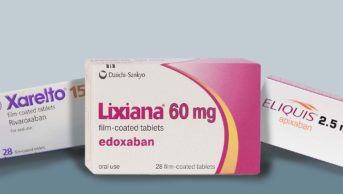This content was published in 2009. We do not recommend that you take any clinical decisions based on this information without first ensuring you have checked the latest guidance.
Oral vitamin K antagonist anticoagulants (eg, warfarin sodium) are prescribed for around 500,000 patients in the UK at any one time1. They are used for several indications, including thromboprophylaxis for patients with atrial fibrillation, or who have undergone a mechanical heart valve replacement or had deep vein thrombosis (DVT). They are also used to treat current DVTs or pulmonary emboli.
Appropriate management of warfarin therapy requires monitoring of patients’ international normalised ratios (INRs). While pharmacists often monitor their patients’ INRs, it is usually doctors who manage patients who have become over- anticoagulated. Nonetheless, pharmacists may need to refer patients for treatment to reverse over-anticoagulation, so a clear understanding of how such patients are managed is essential. It also helps to understand the subsequent care of patients who have undergone warfarin reversal treatment.
Warfarin use is associated with an increased risk of haemorrhage. The precise incidence of haemorrhage due to excessive anticoagulation is difficult to measure, possibly due to variance in how bleeding is classified when treated in different clinical settings. Studies suggest that nearly 1% of haemorrhage cases are fatal2. Oral anticoagulants are, therefore, considered to be a significant potential risk to patient safety.
Treatment options
Overenthusiastic use of vitamin K can cause warfarin resistance when anticoagulation is restarted, which exposes a patient to an increased risk of thrombosis. Before vitamin K is administered, the potential for warfarin resistance must be balanced against the risk of bleeding — determined according to the patient’s indication for anticoagulation.
The treatment options for patients who have been over-anticoagulated are:
- Dose omission;
- Oral phytomenadione (vitamin K1);
- Intravenous phytomenadione;
- Fresh frozen plasma (FFP);
- Prothrombin complex concentrates (PCC).
Which option to use depends mainly on the severity of a patient’s bleeding, or risk of bleeding, at the time of treatment. Clinicians also consider how quickly and to what extent the anticoagulation needs to be reversed. Any requirement for warfarin reversal therapy can serve as an opportunity to review whether warfarin treatment is still necessary for the patient.
Recommendations for managing patients who have been over- anticoagulated are included in the ‘British National Formulary’. Local guidelines may also exist, such as those for hospitals in the north of England on which this article is based.
Asymptomatic patients
Where patients are asymptomatic (ie, not bleeding), their INR is used to determine the need for treatment. Regardless of which treatment is used, it is important to increase the frequency of INR monitoring until it returns to the desired range.
Measuring the INR every 24 hours is usually sufficient unless clinical deterioration occurs.
INR 4.5-7.9
Asymptomatic patients with an INR that is only slightly above the therapeutic maximum can often be managed simply by omitting their usual warfarin dose and increasing their frequency of INR monitoring. The INR will reduce over several days. Warfarin should be restarted, if necessary, when the INR falls below 5.0. Consideration of individual clinical parameters (eg, fall risk, blood pressure, comorbidities) and the patient’s innate sensitivity to warfarin are important when deciding when treatment should be restarted.
Patients at increased risk of bleeding include3:
- Those over 70 years of age;
- Those who have hypertension, diabetes or renal failure;
- Those who have experienced a previous myocardial infarction, stroke or gastrointestinal bleed.
For such patients, mg of phytomenadione should be given orally (as well as omitting their warfarin dose). In most cases, an IV preparation (eg, Konakion MM) is administered orally. However, evidence suggests wide variation in the effectiveness and time taken for a dose of oral phytomenadione to lower a patient’s INR4.
INR above 8.0
Asymptomatic patients with an INR above 8.0 should have their warfarin dose omitted and be given 1mg of phytomenadione orally.
If the INR is greatly above 8.0 (upwards of 10.0 for a patient with no risk factors for falls or haemorrhage), or the patient is elderly and at risk of a fall, 1-2mg of IV phytomenadione may be considered.
Bleeding patients
Haemorrhage can occur even when the INR is within its intended range. For bleeding patients, the severity of haemorrhage governs whether or not warfarin reversal treatment is used and the type of treatment — not the INR level.
Minor bleeding
Minor bleeding would include patients who present with bruising or epistaxis of limited duration. Anticoagulated patients who are experiencing minor bleeding should have their warfarin doses omitted and be given 2mg of oral phytomenadione. If the patient has a significantly high INR (above 8.0 for a patient with no risk factors for falls or haemorrhage) or is at risk of falling, he or she should be given 1-2mg of IV phytomenadione.
Major bleeding
Major bleeding can be subdivided into two categories. First is haemorrhage that poses a risk to life, limb or sight. This includes intracranial, retroperitoneal, intraocular, pericardial and muscular bleeding. Second is haemorrhage that does not cause major haemodynamic compromise (i.e., a substantial drop in blood pressure), hence is not life-, limb- or sight- threatening. Examples of this include some GI bleeds or continuous epistaxis2.
The aim of treatment should be to arrest the haemorrhage as quickly as possible and stabilise the patient, thereby limiting further harm.
The risk of warfarin resistance is less relevant in this situation but must still be considered, particularly for patients at major risk of thrombosis (e.g., those with a major thrombophilia or recipients of older heart valve prosthetics). The method of reversal treatment depends on the patient’s overall clinical picture.
Prothrombin complex concentrate
PCCs are concentrates of specific amounts of vitamin K-dependent clotting factors obtained from pooled plasma products. There are several PCCs available in the UK, each containing different amounts of Factors II, VII, IX and X, and Proteins C and S.
Beriplex, for example, contains therapeutic levels of all four of these factors. Other products contain only three of these factors. Furthermore, levels of Factor VII in these products are lower than in Beriplex. Studies suggest that PCCs lower a patient’s INR further and more rapidly than FFP5,6. However, obtaining patient outcome data for this patient cohort is difficult, due to the urgency with which treatment needs to be administered.
PCCs are recommended for major bleeding that is life-, sight- and limb- threatening. They are particularly useful for treating patients with intracranial haemorrhage. The outcomes for such patients are likely to worsen as the volume of the original bleed and size of the haematoma increase. PCC’s ability to induce a rapid and complete reversal of over-anticoagulation is, therefore, beneficial.
Drawbacks of PCC include its high cost and its potential for causing infection with unknown pathogens — despite being treated for virus inactivation. PCC can be thrombogenic and, in particular, can cause disseminated intravascular coagulation (see Box). However, this is less of an issue for patients who have been excessively anticoagulated2.
PCC must be administered with 5mg of IV phytomenadione. This restores the ability of the body to manufacture vitamin K-dependent clotting factors, allowing the reduction in INR generated by PCC to be maintained.
Disseminated intravascular coagulopathy
Disseminated intravascular coagulopathy is the widespread formation of numerous thrombi in response to a variety of conditions, such as shock or trauma. With so many clots being formed, the body’s stores of coagulation factors and platelets are used up. This results in a reduced ability to form further clots and, therefore, can cause uncontrolled bleeding from, for example, the digestive tract, respiratory tract and any skin wounds. Treatment of this condition varies depending on its underlying cause.
Fresh frozen plasma
FFP is the supernatant obtained after a unit of blood has been centrifuged. Traditionally, it has been the treatment of choice for patients who are bleeding due to over-anticoagulation with warfarin. However, due to issues that limit its suitability, it is no longer used as widely as previously.
Since FFP is a blood product, it presents the same infection transmission risks as any blood transfusion. This risk can be limited by using FFP that has been treated with methylene blue or solvent detergent. However, treated FFP tends to only be used routinely in patients under the age of 16 years — presumably due to its increased cost. The content of vitamin K-dependent clotting factors within FFP products is variable. Some evidence suggests that, by using these products, it can be difficult to achieve a sufficient level of Factor IX to induce haemostasis.
FFP is generally not suitable for use in patients who are overloaded with fluid. Also, FFP cannot be administered as rapidly as PCC, so it is less likely to be used when a coagulopathy needs to be corrected speedily.
Despite these limitations, FFP continues to be widely used for excessive anticoagulation in many areas of the UK and other countries. This is possibly due to its low cost and the limited availability of PCC. The results of two studies5,6 suggest that FFP could be used for major bleeding (without haemodynamic compromise) that is not life-, limb- or sight-threatening. This advice is echoed by the Northern Regional Haematologists Group2.
FFP must also be administered with Smg of IV phytomenadione to ensure the production of endogenous vitamin K- dependent clotting factors.
In Short
Treating patients who have received too much warfarin can be complicated. Most patients who have a high INR but are not bleeding can be managed with simple dosage omission or oral phytomenadione and an increased frequency of INR monitoring.
However, in some circumstances, warfarin can cause severe and life- threatening bleeding, regardless of whether the INR is elevated or not. Such patients may require fresh frozen plasma or prothrombin complex concentrates to replenish their stores of vitamin K-dependent clotting factors.
References
1. Baglin TP, Cousins D, Keeling DM et al. Recommendations from the British Committee for Standards in Haematology and National Patient Safety Agency. Br J Haematol 2006;136:26-9.
2. Hanley JP. Warfarin reversal. J Clin Pathol 2004;57:1132-9.
3. British Committee for Standards in Haematology. Guidelines on oral anticoagulation: third edition. Br J Haematol 1998;101:374-87.
4. Watson HG, Baglin T, Laidlaw SL. A comparison of the efficacy and rate of response to oral and intravenous Vitamin K in reversal of over-anticoagulation with warfarin. Br J Haematol 2001;115:145-9.
5. Makris M, Greaves M, Phillips WS et al. Emergency oral anticoagulant reversal: the relative efficacy of infusions of fresh frozen plasma and clotting factor concentrates on correction of the coagulopathy. J Thromb Haemost 1997;77:47 7-80.
6. Nitu IC, Perry DJ & Lee CA. Clinical experience with the use of clotting factor concentrates in oral anticoagulation reversal. Clin Lab Haematol 2003;20:363-8.


